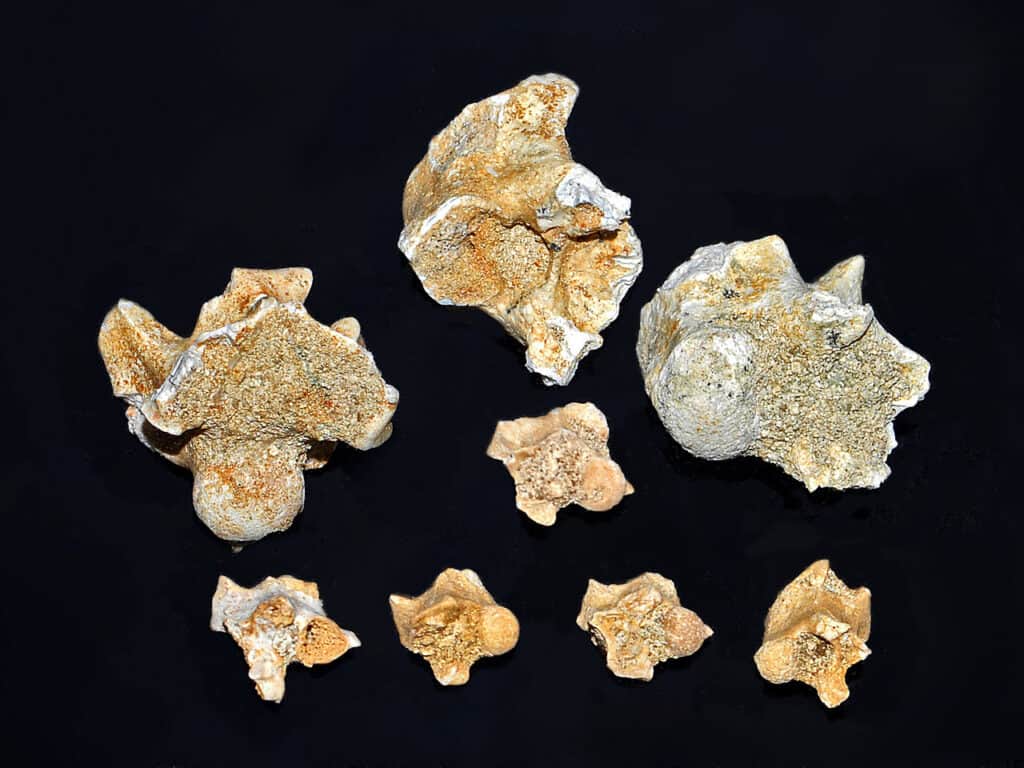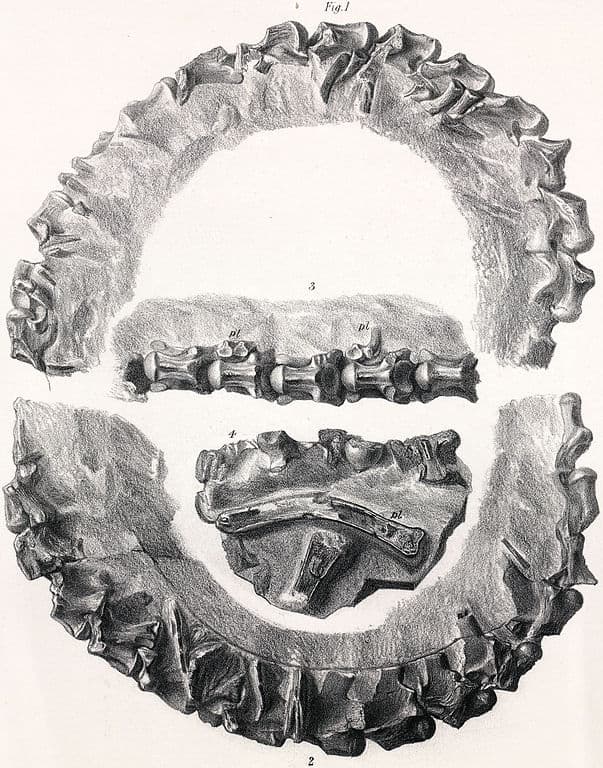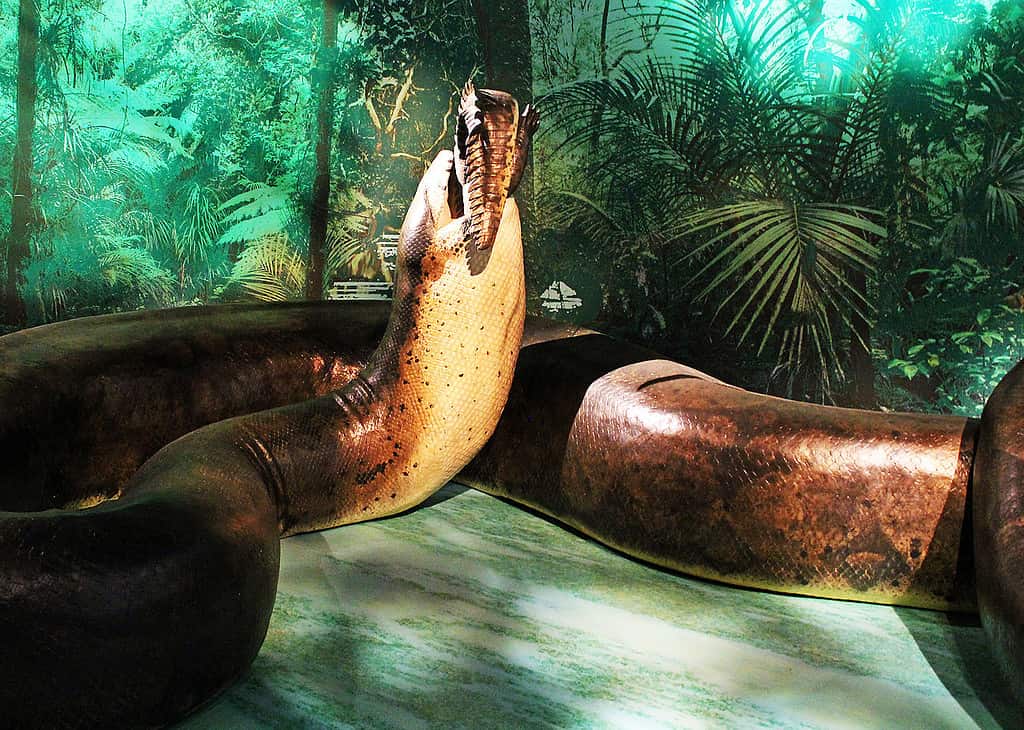There are currently about 52 known species of sea snakes worldwide, and they are all venomous. These aquatic snakes are mainly found in the tropical waters of the Pacific and Indian Oceans and are often non-aggressive unless attacked or cornered.
Until the discovery of Palaeophis colossaeus, an extinct species of sea snake, the yellow sea snake (Hydrophis spiralis) was believed to be the largest sea snake ever discovered in the world, measuring a maximum length of 10 feet (3 meters). How big was the Palaeophis colossaeus? Let’s find out!
Meet Palaeophis Colossaeus, the Massive Sea Snake that Fed on Whales

Palaophis colossaeus can grow up to 40 feet in length.
©Nobu Tamura (http://spinops.blogspot.ca/) / Creative Commons – License
A fossil of Palaeophis colossaeus was found in 1999 by scientists in the Sahara Desert, Mali, in Africa. It was buried in what was believed to be one of the world’s dried-up seas, the Trans-Saharan seaway. The fossils implied to scientists that these giant sea snakes could grow as long as 40 feet in body length and spent most of their time in the ancient seaway. This length puts the giant snake far ahead of the yellow sea snake – about 30 feet longer than the yellow sea snake.
The sea snake belonged to an extinct genus of aquatic snakes called Palaeophis, dubbed ‘ancient snake.’ Palaeophis colossaeus is one of the largest members of the extinct snake family Palaeophiidae. The smallest sea snake species of the family was the Palaeophis casei, which measured about 4.3 feet (1.3 meters) in length.
Was the Palaeophis Colossaeus Venomous?
All present-day species of sea snakes are venomous. However, there is little conclusive data to determine whether the massive sea snake was venomous or not, as its skull was not found with the rest of its fossil remains.
According to some unconfirmed sources, it is possible that the Palaeophis colossaeus was not venomous. Deep within the ancient seas, this huge sea snake had much smaller prey to pick from and was large enough to have been an apex predator.
Scientists, however, are led to believe that Palaeophis colossaeus would either have been venomous or a constrictor like anacondas and pythons. Given its giant size, it would have been rather easy for the aquatic snake to wrap itself around most prey.
Where Did the Largest Sea Snake in the World Live?

Palaeophis colossaeus lived in the Trans-Saharan Seaway.
©Hectonichus / CC BY-SA 3.0 – License
Palaeophis colossaeus lived in the Sahara Desert. The Sahara Desert is the biggest subtropical desert in the world, spanning 3,552,140 square miles (9,200,000 square kilometers), and is certainly no place for a sea snake. However, millions of years ago, the Sahara Desert was covered in water, and this extinct sea was called the Trans-Saharan Seaway. This sea, which extended from the northern parts of Africa to what is now known as the South Atlantic Ocean, covered about 1,158.306 square miles (3,000 square kilometers). It was theorized to have been about 984.25 feet (300 meters) above current sea levels.
A scientific expedition led by Professor Maureen O’Leary solidified early assumptions that the Sahara Desert had once been a seaway. Fossils in the desert indicate that some of the largest aquatic animals had lived there 50-100 million years ago. One of the many giants that swam through the Trans-Saharan seaway was the Palaeophis colossaeus. Palaeophis colossaeus would have been provided with a vast diet option in the seaway where other giant creatures, microbial species, and unique plants would have roamed.
Sadly, the Trans-Saharan seaway and its giant ecosystem are no more. However, more fossils have been found in the present-day desert, telling us more about the giant animals of that age. According to a study, periodic isolation of the seaway alongside other properties is believed to have encouraged gigantism in inhabitants.
Did Palaeophis Colossaeus Really Feed On Whales?

Palaeophis Colossaeus was big enough to feed on whales.
©J. Dinkel / public domain – License
For years, whales have been considered the largest animals in the world. The largest whale species in the world is the blue whale (Balaenoptera musculus), which can grow up to 105 feet (32 meters) long. According to ORCA, the smallest whale species is the dwarf sperm whale, which grows 6.6 -8.9 feet (2-2.7 meters) long. Whales are an extremely large species of animals with a tiny pool of predators other than humans.
Like other whale predators such as polar bears, sharks, and orcas, Palaeophis colossaeus would have been able to feed on smaller whales easily. Besides, sea snakes have been known to feed on prey 1.2 times larger than their necks, and the same is believed of the large sea snake. Not many sea predators would have been capable of preying on Palaeophis colossaeus had it survived extinction.
The Massive Sea Snake vs. Other Giants of the Eocene
When new massive prehistoric fossils are found, the first question on everyone’s minds is: how would it fare against King Kong? The largest sea snake fares decently next to the televised giant. However, several other giant creatures lived and thrived in the era of Palaeophis colossaeus and the dried-up African seaway. According to the Guardian, these giant animals included large whales, long catfish, bony fish, and giant turtles.
Palaeophis colossaeus is the largest sea snake ever discovered in the world, but it is not the largest snake. The title of the largest snake (land and sea) goes to the Titanoboa (Titanoboa cerrejonensis), which measured an average length of 42 feet (12.80 meters) and could grow as long as 50 feet (15.24 meters). However, there is little evidence to prove that these two giant snakes ever encountered each other in history.
Palaeophis colossaeus was not the only 40-foot-long giant found in the hidden cove of ancient monsters. The largest crocodile to ever have lived, Sarcosuchus imperator, tagged the Supercroc was likely about 40 feet from snout to tail and weighed more than 17,000 pounds (7,711 kilograms). Both fossils were found in the Sahara Desert.
Scientists developed the idea that between the Cretaceous and early Paleogene periods, animals experienced gigantism. The Palaeophis Colossaeus would not have had a lot of predators, given its massive size.
What Other Snakes Are 40 Feet Long?

It’s hard to believe, but the Titanoboa was even bigger than Palaeophis colossaeus.
©Ryan Quick from Greenbelt, MD, USA, CC BY 2.0, via Wikimedia Commons – License
Giant snakes have been a source of fascination and fear throughout history. Some of the most impressive specimens have measured over 40 feet in length. Today, the largest known snake in the world is the reticulated python, which can reach lengths of up to 20 feet. However, there have been some other snakes in the past that have been even larger.
The anaconda is another snake that can reach lengths of up to 20 feet. This powerful constrictor is found in South America and is known for its thick, muscular body and powerful coils. A close relative, the green anaconda, can grow up to 20 feet in length.
The Titanoboa is a giant snake that lived in the rainforests of South America during the Paleocene epoch, around 60 million years ago. It is the largest snake ever discovered, measuring up to 50 feet in length and weighing as much as 2,500 pounds. Its scientific name is Titanoboa cerrejonensis.
The Titanoboa is believed to have been an apex predator, preying on fish, turtles, crocodilians, and other animals. It had a powerful, muscular body and was well-adapted to life in the water, able to swim quickly and strike its prey with lightning speed.
The fossilized remains of the Titanoboa were discovered in 2009 in a coal mine in Colombia. This discovery has provided scientists with important insights into the climate and environment of this period of history.
Studying the Titanoboa has helped scientists to understand how life evolved after the mass extinction event that killed off the dinosaurs. It has also provided them with an idea of the size and power of the giant snakes that roamed the earth millions of years ago.
The photo featured at the top of this post is © Rich Carey/Shutterstock.com
Discover the "Monster" Snake 5X Bigger than an Anaconda
Every day A-Z Animals sends out some of the most incredible facts in the world from our free newsletter. Want to discover the 10 most beautiful snakes in the world, a "snake island" where you're never more than 3 feet from danger, or a "monster" snake 5X larger than an anaconda? Then sign up right now and you'll start receiving our daily newsletter absolutely free.
Thank you for reading! Have some feedback for us? Contact the AZ Animals editorial team.






